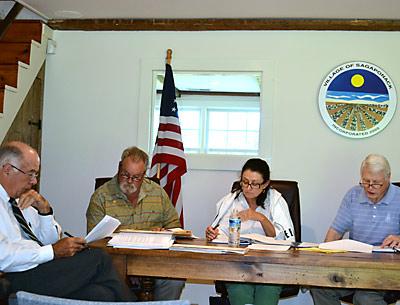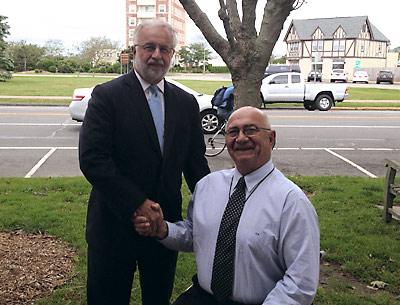Progress Is Elusive on All Counts
Progress Is Elusive on All Counts
Town Supervisor Bill Wilkinson placed 14 items on the agenda for an East Hampton Town Board work session on Tuesday, all of which, he told the board, “We have to take action on or kick aside.”
All had been previously discussed. Some were left hanging because of issues that arose during initial talks, or board members’ questions or requests for more information.
Several had been the subject of resolutions, offered by Mr. Wilkinson or Councilwoman Theresa Quigley, which had failed to pass, deadlocking 2-2 along party lines in the absence, at a recent meeting, of the third Republican board member, Dominick Stanzione.
The Republican supervisor and Ms. Quigley often take one side of an issue, with the Democrats, Peter Van Scoyoc and Sylvia Overby, voicing their own opinions. Dominick Stanzione, a Republican elected on the same slate with Mr. Wilkinson and Ms. Quigley, increasingly constitutes the swing vote.
A rehash on Tuesday of the board’s previous discussions about regulating outdoor gatherings at restaurants and bars, where growing crowds have prompted noise and traffic complaints, was illustrative of the impasse.
“Are we moving forward?” Mr. Wilkinson asked. Although board members had agreed that something should be done to create more leverage for the town to address problematic situations, they failed to agree on how it should be done. Councilwoman Quigley suggested that the ball was now in Mr. Van Scoyoc and Ms. Overby’s court.
“I want to be clear, it’s not me,” Ms. Quigley said. “I made a proposal, and about a month ago I washed my hands of it because there was a disagreement about what ability the current code gives us. So I have nothing to do with it.”
Besides questions from the Democratic members of the board, who asserted that existing codes could be brought to bear on establishments that repeatedly have large outdoor gatherings, Ms. Quigley’s proposal to issue “entertainment permits” was opposed both by business owners, decrying additional regulation, and by those concerned about curbing outdoor crowds, who said the permits would in fact legitimize the activities.
Mr. Wilkinson then brought up a resolution that had not been passed, to request proposals from information technology businesses with an eye to disbanding the town’s own I.T. Department.
“Is that dead?” the supervisor asked. “Theresa and I voted for it — is it dead?”
“I’m not going to support it,” Councilman Stanzione told him. “So that’s dead?” said Mr. Wilkinson. “For now,” Mr. Stanzione said. “I’m tired of kicking cans,” Mr. Wilkinson said.
On changes to an outdoor lighting law, Ms. Quigley, who had convened a committee to draft a new code after her original revision drew criticism, said that “quite frankly, the law is ready, but the committee is stuck in whatever a committee is stuck in when it can’t come out of committee.”
“Is it ready to be distributed to the other board members?” Councilwoman Overby asked. “You have to ask the committee,” Ms. Quigley said. Loring Bolger, a member of the committee, said yesterday that the group was still working on the legislation.
Next, a proposal to add a specific definition to the town code of the term “light trucks” came up. Residents of some neighborhoods have complained about business owners parking work vehicles at their houses, and a town code provision is designed to limit commercial vehicle-parking in residential areas.
“I think that the last time we talked about it, that some of the board members had wondered about providing someplace for people who had trucks above 10,000 pounds,” Mr. Van Scoyoc said.
Ms. Quigley said the code change was requested by Patrick Gunn, the public safety division administrator, who said that the law on the books is ambiguous and not easily enforced.
“So if code enforcement has problems enforcing, it’s because we have laws that we refuse to change because we got off on a tangent,” the councilwoman said. Board members agreed to have a hearing on the change to consider public opinion.
A discussion of a new septic system for the Three Mile Harbor Trailer Park in East Hampton provoked an argument. Ms. Quigley and Mr. Wilkinson have endorsed spending almost $600,000 to install a custom-designed system at the park, which is home to 16 families and close to the mouth of Three Mile Harbor.
It is owned cooperatively by the residents now, but was purchased from the town, which promised to upgrade the septic system. Septic waste constantly overflows, and the system must continually be pumped out. To help out, the town does not charge for dumping the waste at its scavenger waste transfer station.
The situation has posed a problem across several administrations, with the failure of the first septic system put in by the town, and a reluctance on the part of officials to spend the money needed to rectify the situation, or to ignore it, or to displace the generally low-income residents there.
Money for a new septic system has been included in the town’s capital budget, and low-cost, long-term loans are available through a state agency.
Mr. Van Scoyoc and Ms. Overby have suggested that the board look into alternative waste treatment systems, or other solutions, citing the environmental sensitivity of the area and the lack of a guarantee that the proposed new system will work. And Mr. Stanzione said Tuesday that the situation should perhaps be addressed in the context of an overall septic waste management plan for the town, which he is drafting.
Ms. Quigley expressed frustration with a possible delay. The system that has been designed has been approved by state and county agencies, she said. “We should probably inspect every single septic system along Three Mile Harbor. Let’s do that, and let’s hire someone to help us. It’ll probably take about five years, and who knows what it will cost us — but let’s study it. And meanwhile, what will happen to the health and safety of those people?”
She urged Mr. Wilkinson to drop the subject. “Let’s just keep it moving,” she said. “It’s so many words — it’s exhausting.’ ”
“At some point, we have to complete a transaction,” the supervisor said.
“I don’t want to waste any more time on these issues — the talking,” Ms. Quigley responded. When Mr. Van Scoyoc asked about the deadline for requesting state funding, she interrupted, “I can’t take this; I honestly can’t take this.”
Another issue that has been deadlocked gained some ground on Tuesday. Following the recommendation of the state comptroller and Charlene Kagel, the town’s chief auditor, Mr. Wilkinson had proposed establishing an audit committee to oversee annual outside audits. It was defeated in a 2-to-2 vote on June 7.
Proposed members included Mr. Wilkinson, Ms. Quigley, Carole Campolo, a member of the town Republican Committee, and Stanley Arkin, a town resident. Ex-officio members were to include Len Bernard, the town budget officer, Ms. Kagel, and Mr. Gunn.
“I have some concern about the makeup of the committee,” said Councilman Stanzione. He suggested adding another community member to the mix, “to give the committee some bipartisan flavor.”
Ms. Quigley said she would rather remove herself from the committee “and allow that spot to be filled by someone from the Democratic Party, if that’s what will make it go forward.”
Mr. Van Scoyoc questioned whether any town board members should be part of the group. According to a survey of audit committees in other towns, Mr. Bernard said, that practice is common. “The reason is because the governing board, the elected board, is responsible,” he said, for ensuring that the annual audit is done according to proper accounting standards.




